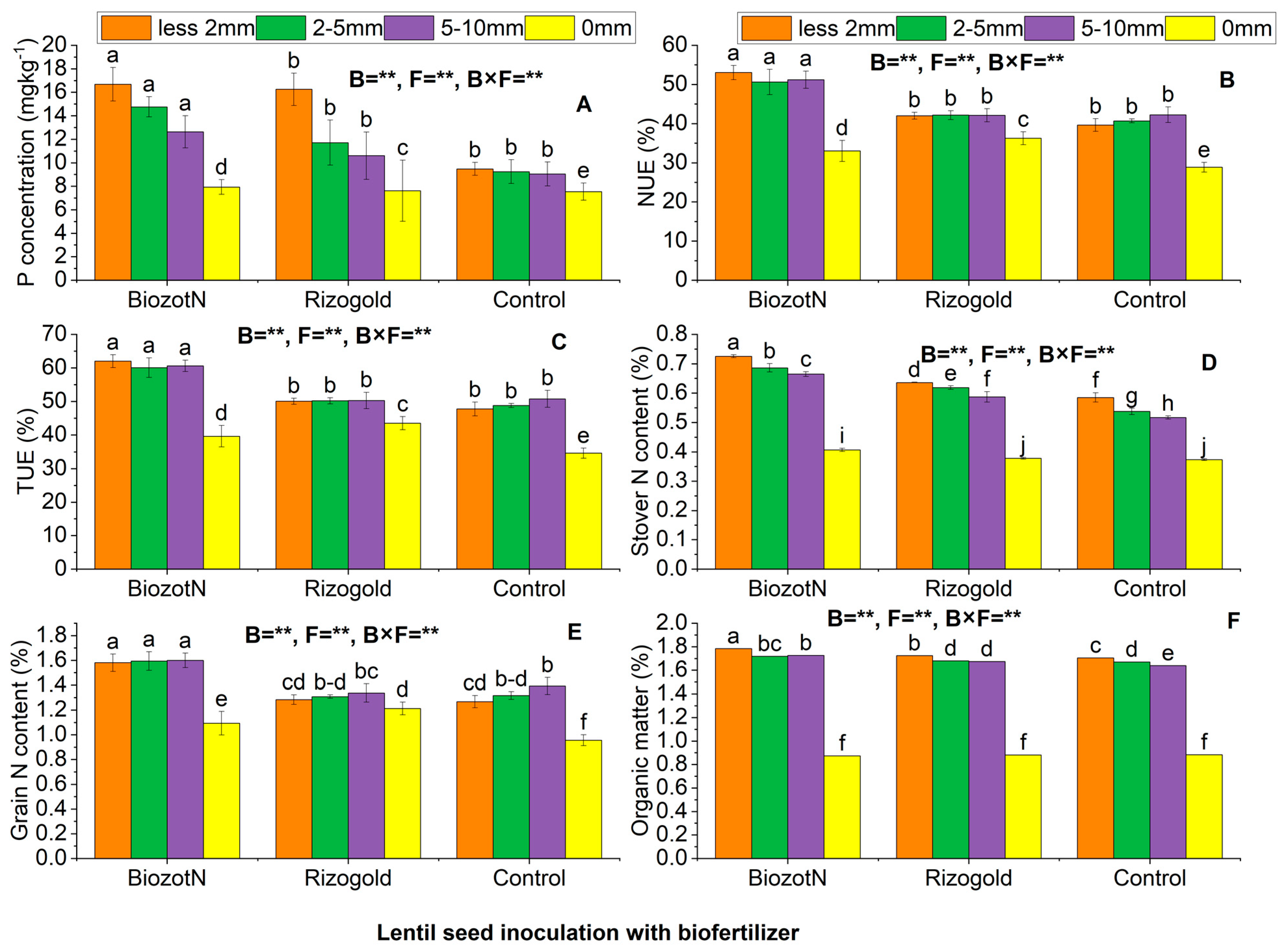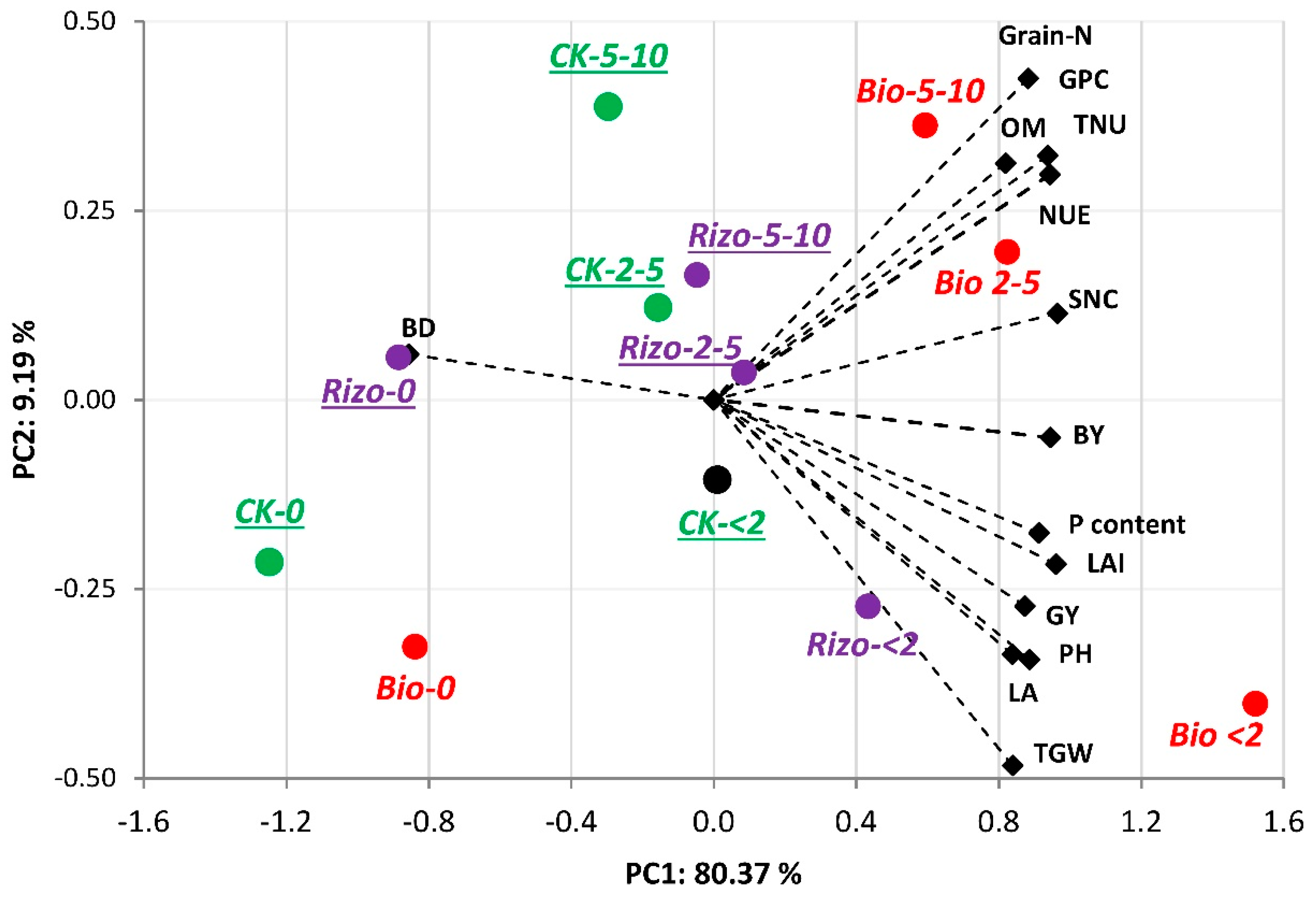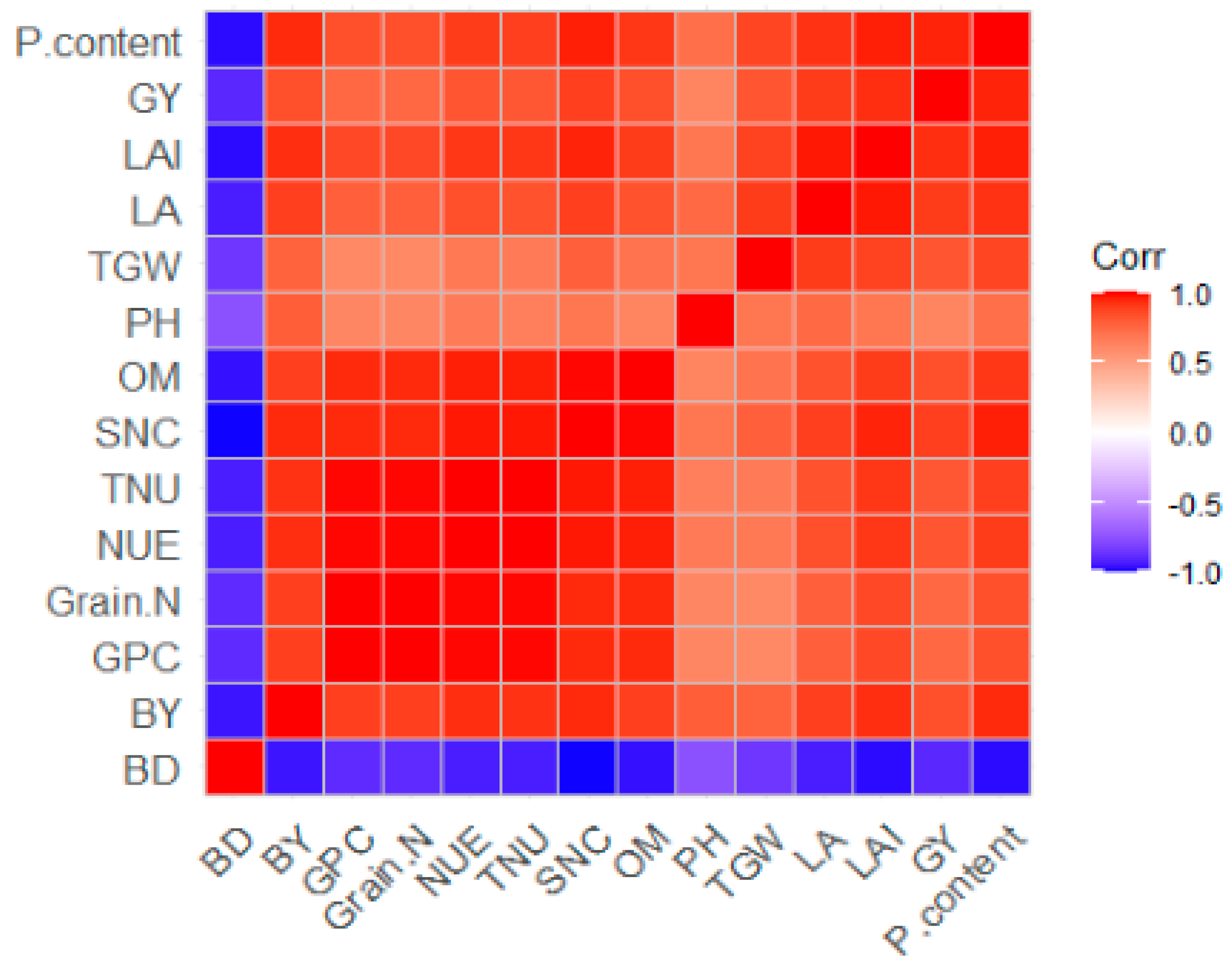Residual Effect of Finely-Ground Biochar Inoculated with Bio-Fertilization Impact on Productivity in a Lentil–Maize Cropping System
Abstract
:1. Introduction
2. Material and Methods
2.1. Cropping History of the Site
2.2. Biochar Particle Size and Rhizobia Strains
2.3. Data Collection
2.4. Soil Sampling and Analysis
2.5. Statistical Analysis
3. Results
3.1. Plant Growth and Soil Bulk Density
3.2. Yield and Yield Components
3.3. Crop Tissues N, N Uptake, and Uptake Use Efficiency
3.4. Principal Component Analysis (PCA) and Pearson’s Correlation Analysis
4. Discussion
5. Conclusions
Author Contributions
Funding
Data Availability Statement
Acknowledgments
Conflicts of Interest
References
- DeLuca, T.H.; Gao, S. Use of Biochar in Organic Farming. In Organic Farming; Springer: Cham, Swizterland, 2019; pp. 25–49. [Google Scholar] [CrossRef]
- Ayaz, M.; Feizienė, D.; Tilvikienė, V.; Akhtar, K.; Stulpinaitė, U.; Iqbal, R. Biochar Role in the Sustainability of Agriculture and Environment. Sustainability 2021, 13, 1330. [Google Scholar] [CrossRef]
- Rasool, M.; Akhter, A.; Soja, G.; Haider, M.S. Role of biochar, compost and plant growth promoting rhizobacteria in the management of tomato early blight disease. Sci. Rep. 2021, 11, 6092. [Google Scholar] [CrossRef]
- Zeeshan, M.; Ahmad, W.; Hussain, F.; Ahamd, W.; Numan, M.; Shah, M.; Ahmad, I. Phytostabalization of the heavy metals in the soil with biochar applications, the impact on chlorophyll, carotene, soil fertility and tomato crop yield. J. Clean. Prod. 2020, 255, 120318. [Google Scholar] [CrossRef]
- El-Naggar, A.; Lee, S.S.; Rinklebe, J.; Farooq, M.; Song, H.; Sarmah, A.K.; Zimmerman, A.R.; Ahmad, M.; Shaheen, S.M.; Ok, Y.S. Biochar application to low fertility soils: A review of current status, and future prospects. Geoderma 2019, 337, 536–554. [Google Scholar] [CrossRef]
- Cabrera, A.; Spokas, K. Impacts of Biochar (Black Carbon) Additions on the Sorption and Efficacy of Herbicides. Herbic. Environ. 2011, 13, 315–340. [Google Scholar] [CrossRef]
- Wang, J.; Xiong, Z.; Kuzyakov, Y. Biochar stability in soil: Meta-analysis of decomposition and priming effects. GCB Bioenergy 2015, 8, 512–523. [Google Scholar] [CrossRef]
- Frimpong, K.A.; Phares, C.A.; Boateng, I.; Abban-Baidoo, E.; Apuri, L. One-time application of biochar influenced crop yield across three cropping cycles on tropical sandy loam soil in Ghana. Heliyon 2021, 7, e06267. [Google Scholar] [CrossRef] [PubMed]
- Cornelissen, G.; Jubaedahp; Nurida, N.L.; Hale, S.E.; Martinsen, V.; Silvani, L.; Mulder, J. Fading positive effect of biochar on crop yield and soil acidity during five growth seasons in an Indonesian Ultisol. Sci. Total Environ. 2018, 634, 561–568. [Google Scholar] [CrossRef]
- Wang, Z.Y.; Chen, L.; Sun, F.L.; Luo, X.X.; Wang, H.F.; Liu, G.C.; Xu, Z.H.; Jiang, Z.X.; Pan, B.; Zheng, H. Effects of adding biochar on the properties and nitrogen bioavailability of an acidic soil. Eur. J. Soil Sci. 2017, 68, 559–572. [Google Scholar] [CrossRef]
- Domingues, R.R.; Sánchez-Monedero, M.A.; Spokas, K.A.; Melo, L.C.A.; Trugilho, P.F.; Valenciano, M.N.; Silva, C.A. Enhancing Cation Exchange Capacity of Weathered Soils Using Biochar: Feedstock, Pyrolysis Conditions and Addition Rate. Agronomy 2020, 10, 824. [Google Scholar] [CrossRef]
- Yang, F.; Zhao, L.; Gao, B.; Xu, X.; Cao, X. The Interfacial Behavior between Biochar and Soil Minerals and Its Effect on Biochar Stability. Environ. Sci. Technol. 2016, 50, 2264–2271. [Google Scholar] [CrossRef] [PubMed]
- Ali, A.; Ahmad, W.; Zeeshan, M.; Khan, F.; Billah, M.M. Biochar and Biofertilizers Residual Effect on Fertility Status of Soil Two Crop Seasons after their Application. Sarhad J. Agric. 2019, 35, 727. [Google Scholar] [CrossRef]
- Yang, L.; Wu, Y.; Wang, Y.; An, W.; Jin, J.; Sun, K.; Wang, X. Effects of biochar addition on the abundance, speciation, availability, and leaching loss of soil phosphorus. Sci. Total Environ. 2020, 758, 143657. [Google Scholar] [CrossRef] [PubMed]
- Karhu, K.; Kalu, S.; Seppänen, A.; Kitzler, B.; Virtanen, E. Potential of biochar soil amendments to reduce N leaching in boreal field conditions estimated using the resin bag method. Agric. Ecosyst. Environ. 2021, 316, 107452. [Google Scholar] [CrossRef]
- Yan, S.; Niu, Z.; Yan, H.; Yun, F.; Peng, G.; Yang, Y.; Liu, G. Biochar Application Significantly Affects the N Pool and Microbial Community Structure in Purple and Paddy Soils. PeerJ 2019, 7, e7576. [Google Scholar] [CrossRef]
- Liao, W.; Thomas, S.C. Biochar Particle Size and Post-Pyrolysis Mechanical Processing Affect Soil pH, Water Retention Capacity, and Plant Performance. Soil Syst. 2019, 3, 14. [Google Scholar] [CrossRef]
- Chen, J.; Li, S.; Liang, C.; Xu, Q.; Li, Y.; Qin, H.; Fuhrmann, J.J. Response of microbial community structure and function to short-term biochar amendment in an intensively managed bamboo (Phyllostachys praecox) plantation soil: Effect of particle size and addition rate. Sci. Total Environ. 2017, 574, 24–33. [Google Scholar] [CrossRef]
- Xie, T.; Reddy, K.R.; Wang, C.; Yargicoglu, E.; Spokas, K. Characteristics and Applications of Biochar for Environmental Remediation: A Review. Crit. Rev. Environ. Sci. Technol. 2015, 45, 939–969. [Google Scholar] [CrossRef]
- Nosheen, S.; Ajmal, I.; Song, Y. Microbes as Biofertilizers, a Potential Approach for Sustainable Crop Production. Sustainability 2021, 13, 1868. [Google Scholar] [CrossRef]
- Mitter, E.K.; Tosi, M.; Obregón, D.; Dunfield, K.E.; Germida, J.J. Rethinking Crop Nutrition in Times of Modern Microbiology: Innovative Biofertilizer Technologies. Front. Sustain. Food Syst. 2021, 5, 606815. [Google Scholar] [CrossRef]
- Malusá, E.; Sas-Paszt, L.; Ciesielska, J. Technologies for Beneficial Microorganisms Inocula Used as Biofertilizers. Sci. World J. 2012, 2012, 491206. [Google Scholar] [CrossRef] [PubMed]
- Khan, M.N.; Shah, H.; Qureshi, A.H.; Abbasi, S. Biozote Performance on Wheat in On-Farm Trials: Farmers’ Perceptions. Sci. Technol. Dev. 2017, 36, 36–147. [Google Scholar] [CrossRef]
- Panazai, G.M.; Khan, A.; Jan, A.; Kethran, R.; Abdul, S.; Agha, H. Biozote-N Performance in Peas Production under the Influence of Compost Application. Pure Appl. Biol. 2019, 8, 931–941. [Google Scholar] [CrossRef]
- Muhammad, N.; Shah, S.A.; Jan, A.U.; Ullah, I.; Ibrahim, M.; Khan, S. Allocative Efficiency Analysis of Tomato Growers in Mohmand Agency, Pakistan. Sarhad J. Agric. 2017, 33, 366–370. [Google Scholar] [CrossRef]
- Ryan, J.G.; Estefan, G.; Rashid, A. Soil and Plant Analysis-Laboratory Manual; International Center for Agricultrual Research in the Dry Areas (ICARDA): Aleppo, Syria, 2002. [Google Scholar]
- Soltanpour, P.N.; State, C.; Collins, F. Communications in Soil Science and Plant Analysis Use of Ammonium Bicarbonate DTPA Soil Test to Evaluate Elemental Availability and Toxicity. Commun. Soil Sci. Plant Anal. 1985, 16, 37–41. [Google Scholar] [CrossRef]
- Gomez, K.A.; Gomez, A.A. Statistical Procedures for Agricultural Research, 2nd ed.; John Wiley and Sons: New York, NY, USA, 1984; 680p. [Google Scholar]
- Steel, R.G.; Torrie, J.H. Principles and Procedures of Statistics: A Biometrical Approach, 2nd ed.; McGraw-Hill International: Auckland, New Zealand, 1980; Volume 76. [Google Scholar] [CrossRef]
- Das, S.; Mohanty, S.; Sahu, G.; Rana, M.; Pilli, K. Biochar: A Sustainable Approach for Improving Soil Health and Environment. Soil Eros.-Curr. Chall. Future Perspect. Chang. World 2021, 7, 121–138. [Google Scholar] [CrossRef]
- Kapoor, A.; Sharma, R.; Kumar, A.; Sepehya, S. Biochar as a means to improve soil fertility and crop productivity: A review. J. Plant Nutr. 2022, 45, 2380–2388. [Google Scholar] [CrossRef]
- Liao, C.-S.; Xie, Z.-H.; Jien, S.-H. Decomposition and Nutrient Releasing of Biochar Compound Materials in Soil with Different Textures. Processes 2021, 9, 1521. [Google Scholar] [CrossRef]
- Liao, J.; Liu, X.; Hu, A.; Song, H.; Chen, X.; Zhang, Z. Effects of biochar-based controlled release nitrogen fertilizer on nitro-gen-use efficiency of oilseed rape (Brassica napus L.). Sci. Rep. 2020, 10, 11063. [Google Scholar] [CrossRef]
- Dawar, K.; Fahad, S.; Jahangir, M.M.R.; Munir, I.; Alam, S.S.; Alam Khan, S.; Mian, I.A.; Datta, R.; Saud, S.; Banout, J.; et al. Biochar and urease inhibitor mitigate NH3 and N2O emissions and improve wheat yield in a urea fertilized alkaline soil. Sci. Rep. 2021, 11, 17413. [Google Scholar] [CrossRef]
- Gentil, E.; Christensen, T.H.; Aoustin, E. Greenhouse gas accounting and waste management. Waste Manag. Res. J. Sustain. Circ. Econ. 2009, 27, 696–706. [Google Scholar] [CrossRef] [PubMed]
- Glaser, B.; Lehr, V.-I. Biochar effects on phosphorus availability in agricultural soils: A meta-analysis. Sci. Rep. 2019, 9, 9338. [Google Scholar] [CrossRef] [PubMed]
- de Jesus Duarte, S.; Glaser, B.; Pellegrino Cerri, C.E. Effect of Biochar Particle Size on Physical, Hydrological and Chemical Properties of Loamy and Sandy Tropical Soils. Agronomy 2019, 9, 165–180. [Google Scholar] [CrossRef]
- Githinji, L. Effect of biochar application rate on soil physical and hydraulic properties of a sandy loam. Arch. Agron. Soil Sci. 2014, 60, 457–470. [Google Scholar] [CrossRef]
- Ma, N.; Zhang, L.; Zhang, Y.; Yang, L.; Yu, C.; Yin, G.; Doane, T.A.; Wu, Z.; Zhu, P.; Ma, X. Biochar Improves Soil Aggregate Stability and Water Availability in a Mollisol after Three Years of Field Application. PLoS ONE 2016, 11, e0154091. [Google Scholar] [CrossRef]
- Billah, M.M.; Ahmad, W.; Ali, M. Biochar particle size and Rhizobia strains effect on the uptake and efficiency of nitrogen in lentils. J. Plant Nutr. 2019, 42, 1709–1725. [Google Scholar] [CrossRef]
- Irisarri, P.; Cardozo, G.; Tartaglia, C.; Reyno, R.; Gutiérrez, P.; Lattanzi, F.A.; Rebuffo, M.; Monza, J. Selection of Competitive and Efficient Rhizobia Strains for White Clover. Front. Microbiol. 2019, 10, 768. [Google Scholar] [CrossRef]
- Shemawar; Mahmood, A.; Hussain, S.; Mahmood, F.; Iqbal, M.; Shahid, M.; Ibrahim, M.; Ali, M.A.; Shahzad, T. Toxicity of biogenic zinc oxide nanoparticles to soil organic matter cycling and their interaction with rice-straw derived biochar. Sci. Rep. 2021, 11, 8429. [Google Scholar] [CrossRef]
- Mahmud, A.A.; Upadhyay, S.K.; Srivastava, A.K.; Bhojiya, A.A. Biofertilizers: A Nexus between soil fertility and crop productivity under abiotic stress. Curr. Res. Environ. Sustain. 2021, 3, 100063. [Google Scholar] [CrossRef]
- Zhou, M.; Liu, C.; Wang, J.; Meng, Q.; Yuan, Y.; Ma, X.; Liu, X.; Zhu, Y.; Ding, G.; Zhang, J.; et al. Soil aggregates stability and storage of soil organic carbon respond to cropping systems on Black Soils of Northeast China. Sci. Rep. 2020, 10, 265. [Google Scholar] [CrossRef] [Green Version]



| (A) | ||
|---|---|---|
| Parameter | Unit | Value/Remarks |
| Texture | - | Silt loam |
| USDA Classification | Fine loamy, mixed, thermic, typic hapludalfs | |
| Bulk density | g cm−3 | 1.3 |
| Moisture percentage | % | 8.3 |
| Organic carbon | g kg−1 | 3.2 |
| Total N | ″ | 0.1 |
| C/N ratio | - | 32:1 |
| pH1:5 | - | 7.78 |
| EC1:5 | dS m−1 | 0.53 |
| AB-BTPA extracted | ||
| K | mg kg−1 | 72 |
| P | ″ | 4.32 |
| Fe | ″ | 0.9 |
| Cu | ″ | 0.5 |
| Zn | ″ | 0.45 |
| Mn | ″ | 1.52 |
| (B) | ||
| Parameter | Unit | Value |
| Moisture | % | 0.65 |
| C | ″ | 64.3 |
| N | g kg−1 | 0.72 |
| K | ″ | 0.42 |
| P | ″ | 0.25 |
| pH(1:5) | - | 8.2 |
| EC(1:5) | dS m−1 | 0.65 |
| Biofertilizer | Biochar | PH | LA | LAI | BD |
|---|---|---|---|---|---|
| Less 2 mm | 220a | 483.7a | 3.30a | 1.04i | |
| Biozote-N | 2–5 mm | 212ab | 449.7b | 2.92b | 1.07hi |
| 5–10 mm | 205b | 443.7b | 2.88b | 1.19de | |
| Control | 204b | 442.3b | 2.51efg | 1.32ab | |
| Less 2 mm | 208ab | 448.3b | 2.84bc | 1.09ghi | |
| Rhizogold | 2–5 mm | 207ab | 427.0c | 2.63cde | 1.16def |
| 5–10 mm | 207ab | 441.0b | 2.57def | 1.21cd | |
| Control | 203b | 426.0c | 2.41fg | 1.33a | |
| Control | Less 2 mm | 207ab | 449.7b | 2.77bcd | 1.11fgh |
| 2–5 mm | 205b | 442.3b | 2.58def | 1.14efg | |
| 5–10 mm | 202b | 425.3c | 2.48efg | 1.18de | |
| Control | 200b | 408.3d | 2.31g | 1.26bc | |
| +SOV | B | ns | ** | ** | ** |
| F | ns | ** | ** | * | |
| B×F | ns | ** | ns | ns |
| Bio-Fertilizer | Biochar | GY | BY | TGW | GPC |
|---|---|---|---|---|---|
| Less 2 mm | 3558a | 13,814a | 250ab | 15.8a | |
| Biozote-N | 2–5 mm | 3424cde | 13,031ab | 236bc | 15.9a |
| 5–10 mm | 3468bcd | 12,442abc | 233bc | 16.0a | |
| Control | 3379ef | 9926g | 232ab | 10.9e | |
| Less 2 mm | 3504ab | 12,008bcd | 237bc | 12.8cd | |
| Rhizogold | 2–5 mm | 3472bc | 11,767bcde | 231bc | 13.1bcd |
| 5–10 mm | 3419cde | 11,681bcdef | 225c | 13.4bc | |
| Control | 3379ef | 10,044fg | 221b | 12.1d | |
| Less 2 mm | 3408def | 108,66cdefg | 235bc | 12.7cd | |
| Control | 2–5 mm | 3417cde) | 105,17defg | 227bc | 13.2bcd |
| 5–10 mm | 3383ef | 102,96efg | 225bc | 13.9b | |
| Control | 3354f | 101,60efg | 224bc | 9.6f | |
| +SOV | B | ** | ** | ** | ** |
| F | ** | ** | ** | ** | |
| B × F | * | ns | ns | ** |
Publisher’s Note: MDPI stays neutral with regard to jurisdictional claims in published maps and institutional affiliations. |
© 2022 by the authors. Licensee MDPI, Basel, Switzerland. This article is an open access article distributed under the terms and conditions of the Creative Commons Attribution (CC BY) license (https://creativecommons.org/licenses/by/4.0/).
Share and Cite
Ali, A.; Ahmad, W.; Munsif, F.; Khan, A.; Nepal, J.; Wójcik-Gront, E.; Ahmad, I.; Khan, M.S.; Ullah, I.; Akbar, S.; et al. Residual Effect of Finely-Ground Biochar Inoculated with Bio-Fertilization Impact on Productivity in a Lentil–Maize Cropping System. Agronomy 2022, 12, 2036. https://doi.org/10.3390/agronomy12092036
Ali A, Ahmad W, Munsif F, Khan A, Nepal J, Wójcik-Gront E, Ahmad I, Khan MS, Ullah I, Akbar S, et al. Residual Effect of Finely-Ground Biochar Inoculated with Bio-Fertilization Impact on Productivity in a Lentil–Maize Cropping System. Agronomy. 2022; 12(9):2036. https://doi.org/10.3390/agronomy12092036
Chicago/Turabian StyleAli, Amjad, Wiqar Ahmad, Fazal Munsif, Aziz Khan, Jaya Nepal, Elżbieta Wójcik-Gront, Ijaz Ahmad, Muhammad Shahid Khan, Ikram Ullah, Sultan Akbar, and et al. 2022. "Residual Effect of Finely-Ground Biochar Inoculated with Bio-Fertilization Impact on Productivity in a Lentil–Maize Cropping System" Agronomy 12, no. 9: 2036. https://doi.org/10.3390/agronomy12092036






